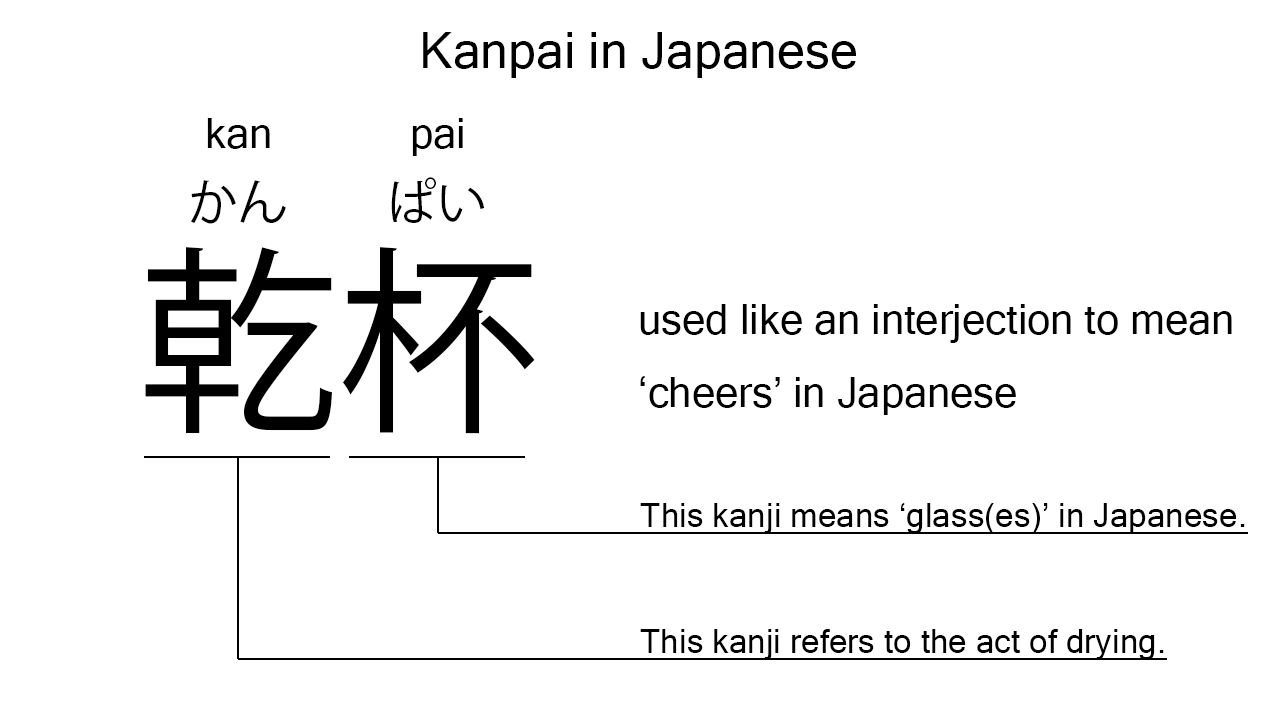What does “kanpai” mean in Japanese?
There are some homophones, but native speakers quite often say kanpai at parties to mean ‘cheers’ in Japanese. Perhaps, some Japanese learners know this word as it is sometimes used in Japanese movies, songs, novels, manga, anime, and the like. In this blog post, however, I will explain this word in detail based on its kanji expression. And also, I will explain how to use it through example sentences. My explanations would help Japanese learners understand kanpai more clearly. Then, let’s get started!
Contents
Definition and meaning of “kanpai”
Let me start with the definition and meaning of kanpai.
- kanpai – 乾杯 (かんぱい) : a noun, but often used like an interjection to mean ‘cheers’ in Japanese.
Grammatically this is a noun. In reality, native speakers use this like an interjection to mean ‘cheers’ in Japanese before drinking.
The definition and meaning are not that difficult, I think. To understand this word more clearly, however, let me explain its kanji characters in detail, one by one.
Kanpai in kanji
The kanji expression of kanpai consists of the following two kanji characters:
- 乾 : a kanji character used to refer to the act of drying or dehydrating in Japanese.
- 杯 : a kanji character used to mean a ‘glass’ or ‘cup’ in Japanese.
From these two kanji characters, we can understand that kanpai literally means ‘drying a glass’ in Japanese. This literal interpretation is not completely in line with the actual meaning, but still understandable as a metaphor for chugging. Drying a glass requires drinking something in it in one gulp. This interjection does not really require us to do so, though.

When we meet new kanji expressions, we should check their kanji characters in detail to understand their meanings clearly and deeply. In many cases, kanji characters tell us a lot about the meanings of the expressions they form. Actually, here, we could get the better understanding of kanpai through the detailed kanji check above.
So far, I’ve explained the definition and meaning of kanpai together with its kanji characters. Then, let me explain how to use it through the example sentences below.
How to say “cheers” in Japanese
「watashi tachi ni kanpai」to kanojo ga it ta – 「私達に乾杯」と彼女が言った (「わたしたちにかんぱい」とかのじょがいった)
“Cheers to us,” she said.
Below are the new words used in the example sentence.
- watashi – 私 (わたし) : a pronoun meaning ‘I’ in Japanese.
- tachi – 達 (たち) : a suffix used after a noun or pronoun to make its plural form. In the example, this is used after watashi to make its plural form, watashi tachi, which means ‘we’ in Japanese. Learn more about Japanese plural.
- ni – に : a case particle used to say to whom a statement is directed. In the example, this is used after watashi tachi to say to whom kanpai is directed.
- to – と : a case particle working as a quote marker. In the example, this works after the clause to indicate what she said.
- kanojo – 彼女 (かのじょ) : a pronoun meaning ‘she’ in Japanese.
- ga – が : a case particle used to make the subject word or the object word in a sentence. In the example, this is used after kanojo to make the subject in the sentence.
- it – 言っ (いっ) : one conjugation of the verb, iu, which means ‘to say’ in Japanese. In the example, it has been conjugated for the better connection with its following word.
- ta – た : an auxiliary verb used after a verb, adjective, or auxiliary verb to make its past tense form. In the example, this is used after it to make its past tense form, it ta.
This is a typical usage of kanpai. In the example, it works together with the case particle, ni, to say “cheers to” in Japanese.
Another example of “kanpai”
「kanpai!」「kanpai!」 – 「乾杯!」「乾杯!」 (「かんぱい!」「かんぱい!」)
“Cheers!” “Cheers!”
This is another example of kanpai. This can also work as an answer to this interjection itself. So, this is really similar to cheers in English.
Summary
In this blog post, I’ve explained the definition and meaning of kanpai in detail based on its kanji expression. And also, I’ve explained how to use it through the example sentences. Let me summarize them as follows.
- kanpai – 乾杯 (かんぱい) : a noun, but often used like an interjection to mean ‘cheers’ in Japanese. These two kanji characters literally mean ‘drying a glass’ in Japanese. This literal interpretation is not completely in line with the actual meaning, but still understandable as a metaphor for chugging. Drying a glass requires drinking something in it in one gulp. This interjection does not really require us to do so, though. This can also work as an answer to this interjection itself. So, this is really similar to cheers in English.
Hope my explanations are understandable and helpful for Japanese learners.
Leave a Reply